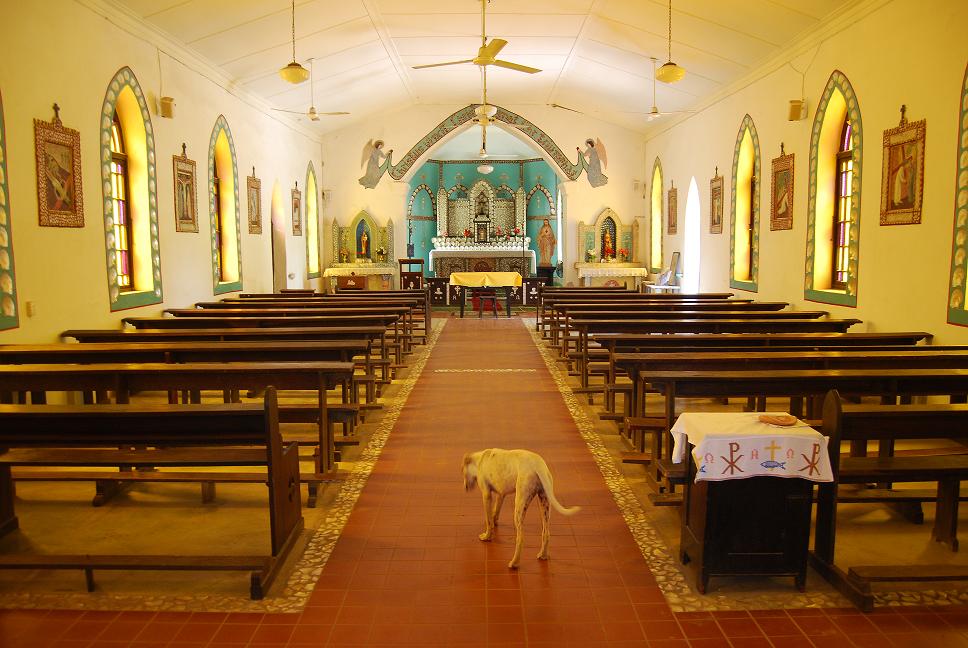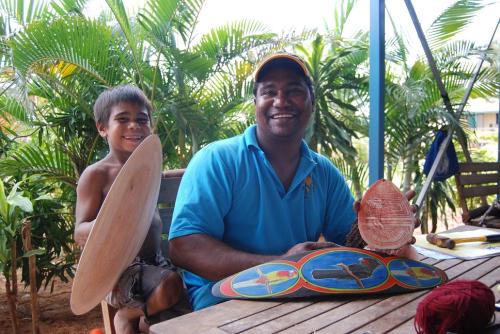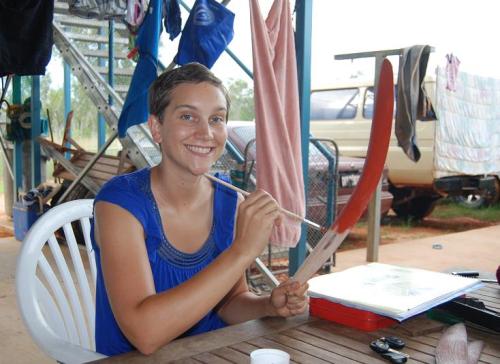Beagle Bay is a small community of about 400 people, about 100 km of Broome, in Western Australia. One of the teachers at the local Primary School gives me a lift, after sunset on a rainy Tuesday evening. The beams of the car are not particularly well designed, as they do not seem to light the potholes, mud parts, corrugations or boggy terrains that we encounter on our 2 and a half hour journey. I was in the passenger seat, and in a good position to see we had absolutely no visibility. Our driver seem to guess the way, making last minute decisions about swerving right or left, changing tracks and going through major puddles (small lakes).

The dirt track to Beagle Bay, with the very helpful sign about halfway. In case you had not noticed before.
As we got out of the car, I was shaking, but relieved to have made it, finally! It had not rained since we last attempted the road, and it was much drier than a few days previous. Over the next weeks, my objectives are to find out about the medical care within the community, and study the books of Chinese medicine I brought along with me.Beagle Bay was first established by a French Catholic priest, who rocked up on the beach at the end of the 19th Century. The local aboriginals, the Nyul Nyul, who were sick of people trying to colonize them, would have killed or scared the ghosts away (white people were thought to be ghosts!) if one of the elders had not had a vision… The aboriginals are always seen as a pacific, gentle-natured culture, but that was not always the case. There were many wars between the locals, and when the whites started invading their homeland bringing diseases and death, they retaliated by being very violent indeed.This elder was a wiseman and medicineman. He had a vision that the spirits would visit: a man and a beautiful woman. When the priest arrived on the beach, knelt down and prayed to a small figurine of the Virgin Mary, the elder stopped the young soldiers from attacking the beach. Mary was the spirit he had seen in his vision. The priest and his followers were welcome to the community and a big feast was organized.Over the years, the settlers learnt the Nyul Nyul language, and taught French and Latin to the locals (very helpful). They founded a school and started brainwashing the children…During the Great War, a handful of German Priests were in Beagle Bay. When the ever so Christian non-German priests decided to give them in and throw them in prison, they started building a Church to prove their goodness… Using only local materials, they decorated the inside with shells from the sea.

Beagle Bay Church - Il n'y a pas un chien... ou presque
The problem with Catholic missionaries, is that they generally beat culture references out of people, and therefore medicinal knowledge tends to disappear, slowly but surely replaced by Western style medicine. Beagle Bay is no exception. My first night out, I socialize with the locals and some of the white teachers. The beer is flowing, as we munch on sushi, dugong stew and deep fried spring rolls. Bugsy plays Country Western music late into the night. The mix of cultures is exceptional. All the white people live in houses around the Church and School, and only 3 of them socialize with the locals. I have a fantastic evening laughingaway, singing along even and getting to know the local ways.
The night after, I meet the white fellas. Different ambiance altogether: here, everyone is whinging about school, getting back to work, the weather, etc. Some people ignore me, as I have not been formally introduced, and I am staying at an unmarried man’s house… What a disgrace!
As I meet and greet people during my first week, I get people to chat to me about the community and its health issues. Most aboriginals don’t want to talk about it. Thankfully, my host Greg facilitates the process by talking directly to those who trust him.
One of the teachers at the school knows Bush Medicine – remedies found in the Bush. We go on a small walkabout, and he talks me through trees, flowers, leaves, barks. This is used for treating colds. This is a contraceptive plant. This tree sap soothes toothache. These leaves in a tea bring sugar levels down. He is very open and happy to talk about a variety of conditions and remedies.
He shows me “bush tucker”: comestible plants one can survive on when in the Bush. How to recognize plants that show water is close to the surface. We also talk about black magic, sorcery and the like.
When we move to manual therapy, he is a bit uneasy. He knows someone who uses his hands to treat, he has seen it happen, but he does not have the gift. He explains that his grand father was a medicine man and healer, who died as his mother was heavily pregnant. My new friend was said to be a “spirit baby”, a form of reincarnation. When he was born, he was praised and treated with much respect. But as he developed, he did not develop any of the faculties his grand father had. He learned about Bush Medicine nonetheless, but later moved away from his family. When I approached this subject, he shut down a little. He had been a disappointment. He was not the spirit baby that his piers were waiting for.
He suggests a medicineman who lives further North on the Peninsula. Unfortunately, all the roads are closed, as there has been a lot of rain recently. Moreover, it is currently “Law” so he is not available.
LAW
This is man’s business: it is boy’s initiation. The boys go out in the outback with the medicine man and a few elders, and are taught basic Bush skills. How to find the right trees for making boomerangs, how to hunt and fish, how to fight, how to find food and water, and the stories of Dreamtime: the songs, legends and dances. At the end of Law, a big ceremony is organized when the boys return to their family. The feasts are said to be exceptional.

- My new friend, his son and the traditional shield and ingraved pearl shell
We talk some more, about my research and my personal quest. He tells me that unfortunately, there are very few “medicine women”, and that a traditional male medicine man could not tell me much about Bush medicine and healing, as he must keep it secret from others, especially women. Like many traditional societies, Aboriginals keep men and women separate. Their culture is based on survival, where each member of the family as their own role. Some hunt, others gathers. Some stay with the children and elders, other gather water. Some treat and heal, other tells stories and dance. They believe that each person has their own talent, and it is a lifelong quest to look for one’s talents and use them for the use of one’s own benefit and the families survival. That is why everything is shared: all food, water, stories, and nowadays: money.
The locals who have integrated into Western society then face a big dilemna: keep ties with their family and therefore distribute their wage, share their house and car; or cut away and make the most of our consumer society?
Most of them cannot keep their motivation, when they see that their money is transformed into alcohol, cigarettes and drugs. When they witness the fruit of their work destroying their family, many stop working and return to the government minimal indigenous income.
Others volunteer, give their art for free, or give all their money to the Church, as they do not want to have to deal with the family politics involved with earning a decent wage.
At the weekend, I indulged in the local past time: driving 4-wheel drives and fishing! A very rudimental “reel” and a huge hook with a piece of squid did the trick. We drove around for hours in dirt tracks (and yes, I mean in, rather than on!), clearing them before we could progress: trees, branches, logs impaired our expedition.

- Learning to fish the local way
Over the course of my stay, I met the local clinic manager, nurses, and locum rural general practitioners. Most of them told me there were many forms of Bush Medicine used in everyday life, especially using local plants, but most of them know nothing on manual therapy.
I was told that elder women helped the young mums in prenatal care and during delivery, but it stayed very vague. As a foreigner to the community, the locals did not have much trust in me, and suddenly forgot everything they knew. I did feel a little like a police person doing an investigation on terrible crimes, especially when the “witnesses” kept contradicting themselves, covering eachother and telling outrageous lies.
But I continued my research, and when I was downhearted, I studied even harder my books on Chinese Medicine. Of course, there is still amazing medicine out there, in the oldest culture in the world, but to find it, I would need at least 6 to 12 months of integration in a rural, faraway community before I could get straight answers to my questions. This time of the year, because of the Wet and the initiation, it is simply not possible. And what would I do for 6 months? I would go stir crazy just sitting around, and with my visa, I cannot work or even volunteer anywhere…
Onwards and upwards. I packed my bag, but left my disappointment behind. I met so many wonderful people, I shared incredible evenings, and worked hard on my books. It was time for me to go, and return to town.

- Helping to prepare for the final ceremony of law
I wanted to leave my mark… so I helped one of my new friends to prepare the boomerangs for the end of initiation. He chose the tree, made the object into its shape, and I got to paint and decorate it. This boomerang will be given to the boy -now a man- and he will cherish them for his whole life, as the symbol of his manhood. Never will he know that it was painted by a white woman! Haha!







